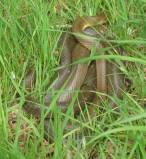
I found this near my house in Wales
The Aesculapian Snake (Elaphe longissima) is a nonvenomous snake native to Europe.
Description[]
They hatch at around 30 cm (11.8 in) and average at around 110 cm (43.3 in) but can grow up to 200 cm (78.7 in). They are dark, long, slender, and shiny. Juveniles can easily be confused with juvenile Grass snakes, also having a yellow collar on their neck. Juveniles are light green or brownish-green with various darker patterns along the flanks and on their back. They appear to have two darker patches in the form of lines running on the top of the flanks. Adults are much more uniform, sometimes being olive-yellow, brownish-green, sometimes almost black. When they have a pale color, sometimes two darker lines can be visible, but if their body color is dark, they usually have white freckles all over their body. Their belly is yellow. With unmisable dark patches
Diet[]
Their main food source are rodents. They also eat lizards and sometimes bird eggs as well as birds. They constrict their prey. Juveniles eat mainly lizards.
Behavior[]
They can be rather tame, confident that their coloration will keep them hidden within their natural environment. They usually disappear and hide, but if cornered they may sometimes stand their ground and try to intimidate their opponent, sometimes with a chewing-like movement of the mouth and occasionally biting. They are active by day. In the warmer months of the year, they come out in late afternoon or early morning. They are very good climbers.
Reproduction[]
Breeding occurs when the snakes wake up from hibernation in spring, a week after, they are all looking for each other and mating begins. After only a few weeks about 15 eggs are laid (extremes are from 9 to 20 eggs) in a moist, warm spot, usually under hay piles, in rotting wood piles and other places of this kind. The eggs incubate for around 10 weeks before hatching
Geographic Range[]
Found over most of France except in the north, the Spanish Pyrenees and the eastern side of the Spanish northern coast, Italy (except the south and Sicily), the Balkan peninsula and parts of Switzerland and Austria. Some isolated populations in western Germany and in the northwest of the Czech Republic.
Introduction to the UK
These snakes were introduced into Wales an area of the UK. They were introduced when a colony of them were released in and around the grounds of the Welsh Mountain Zoo in Colwyn Bay. They escaped from the zoo when the zoo shut down. The colony in North Wales has existed there for 30-40 years. They released all the snakes into the welsh countryside. Numbers are unknown, but the colony is likely to contain at least several dozen individuals. Reproduction appears to occur regularly, as specimens of all size classes can be found, but at present, there is no indication that the species has spread beyond the immediate vicinity of the Zoo. These snakes have also been introduced on a seperate occasion to the central of London. No one knows just how they got there all they know is that they're there. There are about now about 20 breeding pairs in London.
Videos

Aesculapian snake (Zamenis longissimus) in Wales
By Snakes1000000